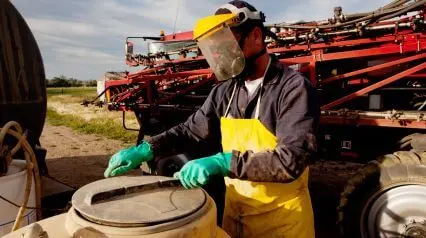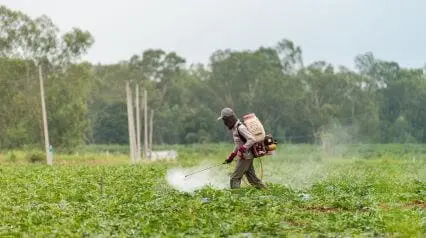What is Good Agricultural Practices?
Good Agricultural Practices (GAP) is a set of standards for the safe and sustainable production of crops and livestock. It aims to help farm owners maximize yields and optimize business operations while also minimizing production costs and environmental impact. Following Good Agricultural Practices makes it easier for producers to supply products with the quality retailers demand and consumers want. Upon request, GAP compliance can be audited by the U.S. Department of Agriculture (USDA) to ensure compliance with Food and Drug Administration (FDA) guidelines.
The Importance of Good Agricultural Practices
Good Agricultural Practices is important because it reinforces responsible farming methods from site selection and land preparation to harvesting and handling. According to the Food and Agriculture Organization of the United Nations (FAO), GAP applies available knowledge to address environmental, economic, and social sustainability for on-farm production and post-production processes, resulting in safe and healthy agricultural products. Implementing Good Agricultural Practices can improve the livelihood of producers and the local economy as a whole, contributing to fulfill national development objectives or sustainable development goals.
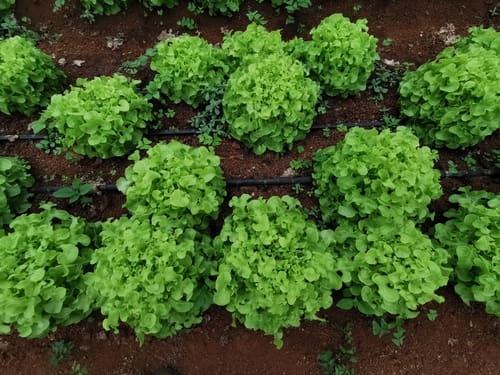
What are the 4 Pillars of Good Agricultural Practices?
The 4 pillars of Good Agricultural Practices are the core principles used for the effective promotion and adoption of GAP. By following these pillars, farmers can build their reputations as providers of affordable yet high-quality goods and keep up with competitive export markets. As described by FAO, the 4 GAP pillars are economic viability, environmental stability, social acceptability, and food safety and quality:
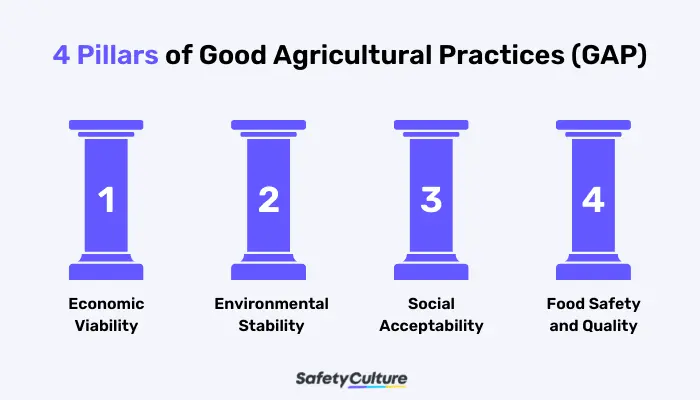
GAP Pillar 1: Economic Viability
This means to maintain viable farming enterprises and contribute to sustainable livelihoods. Generally, it refers to the profit earned from management of productive land. Demonstrate this pillar by providing sufficient evidence on the viability of farm operations such as management reviews, annual reports, and financial plans.
GAP Pillar 2: Environmental Stability
This means to sustain and enhance the natural resource base. The most recent Good Agricultural Practices manual outlines critical requirements such as assessing the risk of causing environmental harm on and off new sites, keeping records of the hazards assessed, and detailing the chemicals used to sterilize soils and substrates. Moreover, the GAP manual indicates major requirements for environmental management such as:
- Highly degraded areas shall be managed to avoid further degradation.
- The production practices selected shall be suitable for the soil type and not increase the risk of environmental degradation.
- The application of fertilizers and soil additives shall be recorded detailing the name of the fertilizer or soil additive, location, date, rate and method of application, and the operator’s name.
- A water management plan to optimize water usage and reduce waste shall be made available.
- Chemicals used for crop protection shall be selected so as to minimize the negative effect on the environment and antagonist organisms of pests and diseases.
- A waste management procedure shall be documented and followed using practices to minimize waste generation, to reuse, recycle waste and dispose of waste, including identification of waste products generated during production, harvesting and handling produce.
- The use of electricity and fuel shall be reviewed to ensure that efficient operation practices are implemented.
- The production plan shall comply with national regulations covering protected plant and animal species and to preserve native plant and animal species, including native vegetation areas, wildlife corridors and vegetation areas on or near the banks of waterways.
- If an offensive odor, or smoke, dust or noise is generated from production practices, management action shall be taken to minimize the impact on neighboring property and surrounding areas.
- Farmers and workers shall be trained to have appropriate knowledge in their areas of responsibility related to GAP and training records shall be kept.
- Records of GAP shall be kept for two years or more in accordance with statutory requirements, if any, or business requirements.
- A review shall be carried out at least once a year to identify any new and emerging hazards resulting from inputs, processes, or hazards affecting the environment.
GAP Pillar 3: Social Acceptability
This means to meet the cultural and social demands of society. An essential way of practicing this principle is to protect the agricultural workers’ health from hazards brought on by the improper use of chemicals and pesticides. They should also be trained on the appropriate knowledge and skills for correct handling and application of hazardous materials.
GAP Pillar 4: Food Safety and Quality
This means to economically and efficiently produce sufficient, safe and nutritious food. Control should begin in the field to reduce the hazards of contamination. To take action on this commitment, evaluate the following elements of food safety and produce quality modules of GAP for fruits and vegetables:
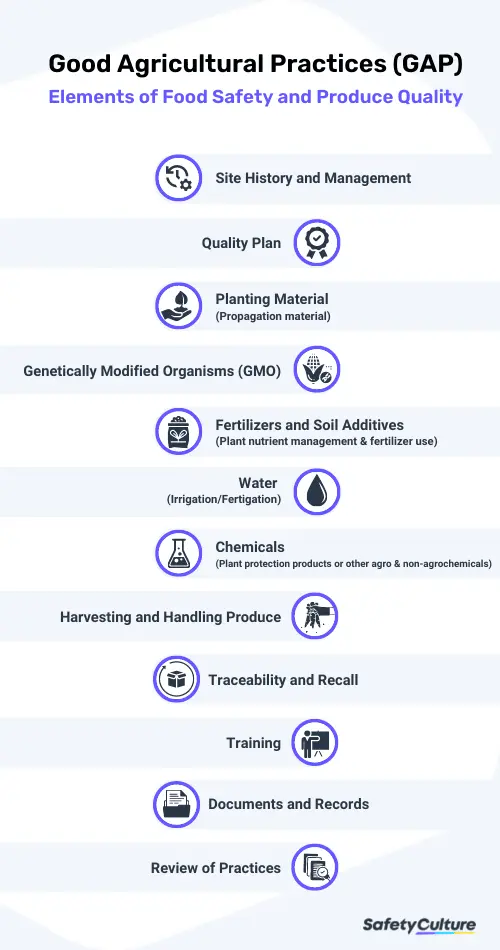
Good Agricultural Practices: Elements of Food Safety and Produce Quality | Information Source
Good Agricultural Practices Examples
When properly performed, GAP can help farm operators stay on top of daily job tasks and have confidence in the integrity of their procedures. While some producers usually associate Good Agricultural Practices with the cultivation of plants, the holistic approach is also often applied in the rearing of livestock. Here are general examples of how GAP can work in different contexts:
GAP Example 1: For growing crops, it involves utilizing appropriate amounts of fertilizer at optimal moments during a crop cycle (e.g., growth, production, and maturation stages), applying compost or manure to maintain the organic content of the soil, and reducing soil erosion by installing hedges or digging ditches.
GAP Example 2: For raising animals, it includes minimizing the usage of non-therapeutic antibodies or hormones, avoiding feeding livestock with animal by-products (such as processed animal protein), and making sure that farms adequately clean equipment and machinery to prevent the spread of disease.
Achieve operational excellence
Cultivate a culture of excellence with our digital solutions that enhance efficiency, agility, and continuous improvement across all operations.
Explore nowWhat is Good Agricultural Practices Certification?
Good Agricultural Practices certification is a process done by an independent certifying body to guarantee that production processes or products of farms meet GAP standards. GAP certification is voluntary, but it is frequently required by buyers such as produce distributors and supermarkets. The USDA Good Agricultural Practices certification is the most basic GAP program administered by the agency. To receive certification, farmers should pass the USDA GAP audit which verifies their compliance with Good Agricultural Practices and Good Handling Practices (GHP) as recommended in the USFDA guide on minimizing microbial food safety hazards for fresh fruits and vegetables.
Create your own GAP Audit Checklist
Build from scratch or choose from our collection of free, ready-to-download, and customizable templates.
GAP Audit ChecklistsPreparing for GAP Certification Using Free Tools
Food safety hazards may occur at different stages of the food chain, so it’s important to address them, starting from the farm level. SafetyCulture (formerly iAuditor) can help farmers establish Good Agricultural Practices, empower workers to sustain them, and prepare for GAP certification. SafetyCulture is an auditing and reporting tool designed to make it easier for producers to gain visibility across farming operations, identify flaws in existing processes, and demonstrate adherence to GAP. Here’s an overview how:
- Auditing: See Good Agricultural Practices come to life in farms by regularly going through GAP/GHP audit verification checklists and GlobalG.A.P. templates. These tools are easy to use on mobile devices such as smartphones, tablets, and iPads. Available without internet connection, producers can start and complete audits from wherever they are. They can also assign actions with priority levels and due dates to address issues or follow-up on concerns.
- Reporting: Records play an essential part in preparing for GAP certification—good thing that every audit done on SafetyCulture is instantly made into a shareable, professional report. Automatically filed in secure online storage for easier record-keeping, completed reports can also be downloaded as PDFs and sent to specific people via email. Farmers can add up to 10 workers or team members using a free SafetyCulture account.


